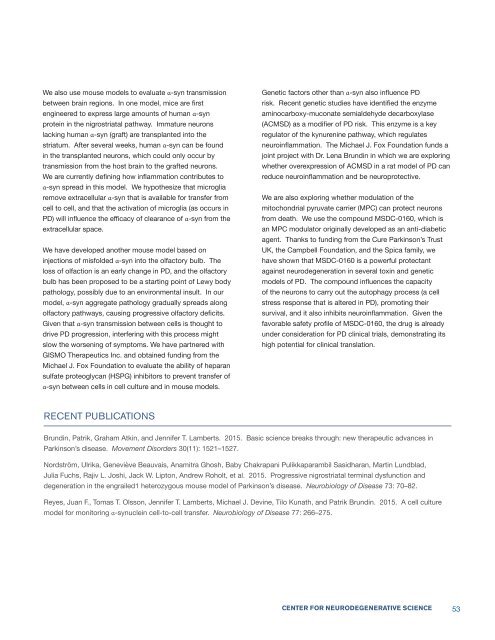2016 Scientific Report
Create successful ePaper yourself
Turn your PDF publications into a flip-book with our unique Google optimized e-Paper software.
We also use mouse models to evaluate α-syn transmission<br />
between brain regions. In one model, mice are first<br />
engineered to express large amounts of human α-syn<br />
protein in the nigrostriatal pathway. Immature neurons<br />
lacking human α-syn (graft) are transplanted into the<br />
striatum. After several weeks, human α-syn can be found<br />
in the transplanted neurons, which could only occur by<br />
transmission from the host brain to the grafted neurons.<br />
We are currently defining how inflammation contributes to<br />
α-syn spread in this model. We hypothesize that microglia<br />
remove extracellular α-syn that is available for transfer from<br />
cell to cell, and that the activation of microglia (as occurs in<br />
PD) will influence the efficacy of clearance of α-syn from the<br />
extracellular space.<br />
We have developed another mouse model based on<br />
injections of misfolded α-syn into the olfactory bulb. The<br />
loss of olfaction is an early change in PD, and the olfactory<br />
bulb has been proposed to be a starting point of Lewy body<br />
pathology, possibly due to an environmental insult. In our<br />
model, α-syn aggregate pathology gradually spreads along<br />
olfactory pathways, causing progressive olfactory deficits.<br />
Given that α-syn transmission between cells is thought to<br />
drive PD progression, interfering with this process might<br />
slow the worsening of symptoms. We have partnered with<br />
GISMO Therapeutics Inc. and obtained funding from the<br />
Michael J. Fox Foundation to evaluate the ability of heparan<br />
sulfate proteoglycan (HSPG) inhibitors to prevent transfer of<br />
α-syn between cells in cell culture and in mouse models.<br />
Genetic factors other than α-syn also influence PD<br />
risk. Recent genetic studies have identified the enzyme<br />
aminocarboxy-muconate semialdehyde decarboxylase<br />
(ACMSD) as a modifier of PD risk. This enzyme is a key<br />
regulator of the kynurenine pathway, which regulates<br />
neuroinflammation. The Michael J. Fox Foundation funds a<br />
joint project with Dr. Lena Brundin in which we are exploring<br />
whether overexpression of ACMSD in a rat model of PD can<br />
reduce neuroinflammation and be neuroprotective.<br />
We are also exploring whether modulation of the<br />
mitochondrial pyruvate carrier (MPC) can protect neurons<br />
from death. We use the compound MSDC-0160, which is<br />
an MPC modulator originally developed as an anti-diabetic<br />
agent. Thanks to funding from the Cure Parkinson’s Trust<br />
UK, the Campbell Foundation, and the Spica family, we<br />
have shown that MSDC-0160 is a powerful protectant<br />
against neurodegeneration in several toxin and genetic<br />
models of PD. The compound influences the capacity<br />
of the neurons to carry out the autophagy process (a cell<br />
stress response that is altered in PD), promoting their<br />
survival, and it also inhibits neuroinflammation. Given the<br />
favorable safety profile of MSDC-0160, the drug is already<br />
under consideration for PD clinical trials, demonstrating its<br />
high potential for clinical translation.<br />
RECENT PUBLICATIONS<br />
Brundin, Patrik, Graham Atkin, and Jennifer T. Lamberts. 2015. Basic science breaks through: new therapeutic advances in<br />
Parkinson’s disease. Movement Disorders 30(11): 1521–1527.<br />
Nordström, Ulrika, Geneviève Beauvais, Anamitra Ghosh, Baby Chakrapani Pulikkaparambil Sasidharan, Martin Lundblad,<br />
Julia Fuchs, Rajiv L. Joshi, Jack W. Lipton, Andrew Roholt, et al. 2015. Progressive nigrostriatal terminal dysfunction and<br />
degeneration in the engrailed1 heterozygous mouse model of Parkinson’s disease. Neurobiology of Disease 73: 70–82.<br />
Reyes, Juan F., Tomas T. Olsson, Jennifer T. Lamberts, Michael J. Devine, Tilo Kunath, and Patrik Brundin. 2015. A cell culture<br />
model for monitoring α-synuclein cell-to-cell transfer. Neurobiology of Disease 77: 266–275.<br />
CENTER FOR NEURODEGENERATIVE SCIENCE<br />
53
















